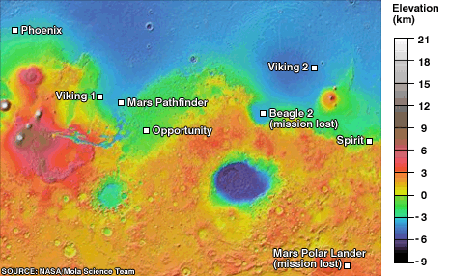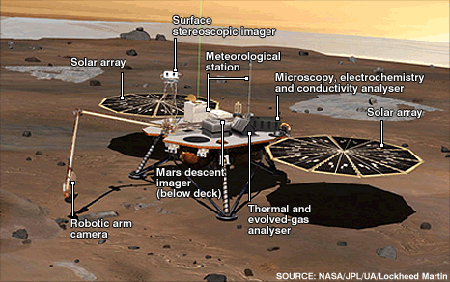You are hereArchive - May 24, 2008
Archive - May 24, 2008
NASA Mars Probe Prepares for Risky Landing
Original Source: BBC News
(quote)
The Phoenix lander is due to touch down on Monday in the far north of the Red Planet, after a 423-million-mile journey from Earth. The probe is equipped with a robotic arm to dig for water ice thought to be buried beneath the surface. Scientists say the mission should give the clearest indication yet of whether Mars could once have harbored life.
The final seven minutes of the probe's ten-month journey is regarded as the riskiest part of the mission. After it enters the top of the Martian atmosphere at nearly 5.7km/s (13,000 mph), the probe must perform a series of maneuvers to come safely to rest. It will release a parachute, use pulsed thrusters to slow to a fast walking speed, then come to a halt on three legs. If all goes to plan, the Phoenix lander will reach the surface of Mars at 0053 BST (1953 EDT) on May 26. Nasa controllers will know in about 15 minutes whether the attempt has been successful.
Landing on Mars is a notoriously tricky business. Of the 11 missions that have tried to land probes on Mars since 1971 - only five have succeeded. Phoenix is an apt name for the current mission, as it rose from the ashes of two previous failures. In September 1999, the Mars Climate Orbiter spacecraft crashed into the Red Planet following a navigation error caused when technicians mixed up "English" (imperial) and metric units. A few months later, another Nasa spacecraft, the Mars Polar Lander (MPL), was lost near the planet's South Pole. Phoenix uses hardware from an identical twin of MPL, the Mars Surveyor 2001 Lander, which was cancelled following the two consecutive failures. The probe was launched on 4 August 2007 on a Delta II rocket from Cape Canaveral Air Force Station in Florida.
(unquote)



Fun, Fitness, and Games - Shigeru Miyamoto’s Newest Wii Fit
Original Source: New York Times
(quote)
IT’S O.K. to liken Shigeru Miyamoto to Walt Disney. When Disney died in 1966, Mr. Miyamoto was a 14-year-old schoolteacher’s son living near Kyoto, Japan’s ancient capital. An aspiring cartoonist, he adored the classic Disney characters. When he wasn’t drawing, he made his own toys, carving wooden puppets with his grandfathers’ tools or devising a car race from a spare motor, string and tin cans. Even as he has become the world’s most famous and influential video-game designer — the father of Donkey Kong, Mario, Zelda and, most recently, the Wii — Mr. Miyamoto still approaches his work like a humble craftsman, not as the celebrity he is to gamers around the world.
Perched on the end of a chair in a hotel suite a few dozen stories above Midtown Manhattan, the preternaturally cherubic 55-year-old Mr. Miyamoto radiated the contentment of someone who has always wanted to make fun. And he has. As the creative mastermind at Nintendo for almost three decades, Mr. Miyamoto has unleashed mass entertainment with a global breadth, cultural endurance and financial success unsurpassed since Disney’s fabled career.
Mario, the mustached Italian plumber he created almost 30 years ago, has become by some measures the planet’s most recognized fictional character, rivaled only by Mickey Mouse. As the creator of the Donkey Kong, Mario and Zelda series (which have collectively sold more than 350 million copies) and the person who ultimately oversees every Nintendo game, Mr. Miyamoto may be personally responsible for the consumption of more billions of hours of human time than anyone around. In the Time 100 online poll conducted this spring, Mr. Miyamoto was voted the most influential person in the world.
But it isn’t just traditional gamers who are flocking to Mr. Miyamoto’s latest creation, the Wii. Eighteen months ago, just when video games were in danger of disappearing into the niche world of fetishists, Mr. Miyamoto and Satoru Iwata, Nintendo’s chief executive, practically reinvented the industry. (Mr. Miyamoto’s full title is senior managing director and general manager of Nintendo’s entertainment analysis and development division.) Their idea was revolutionary in its simplicity: rather than create a new generation of games that would titillate hard-core players, they developed the Wii as an easy-to-use, inexpensive diversion for families (with a particular appeal to women, an audience generally immune to the pull of traditional video games). So far the Wii has sold more than 25 million units, besting the competition from Sony and Microsoft.
Last week Nintendo released its new Wii Fit system in North America, a device that hopes to make doing yoga in front of a television screen almost as much fun as driving, throwing, jumping or shooting in a traditional game. Though there were no hard sales figures available as of Tuesday, there were reports of stores across the country selling out of Wii Fit.
(unquote)




















